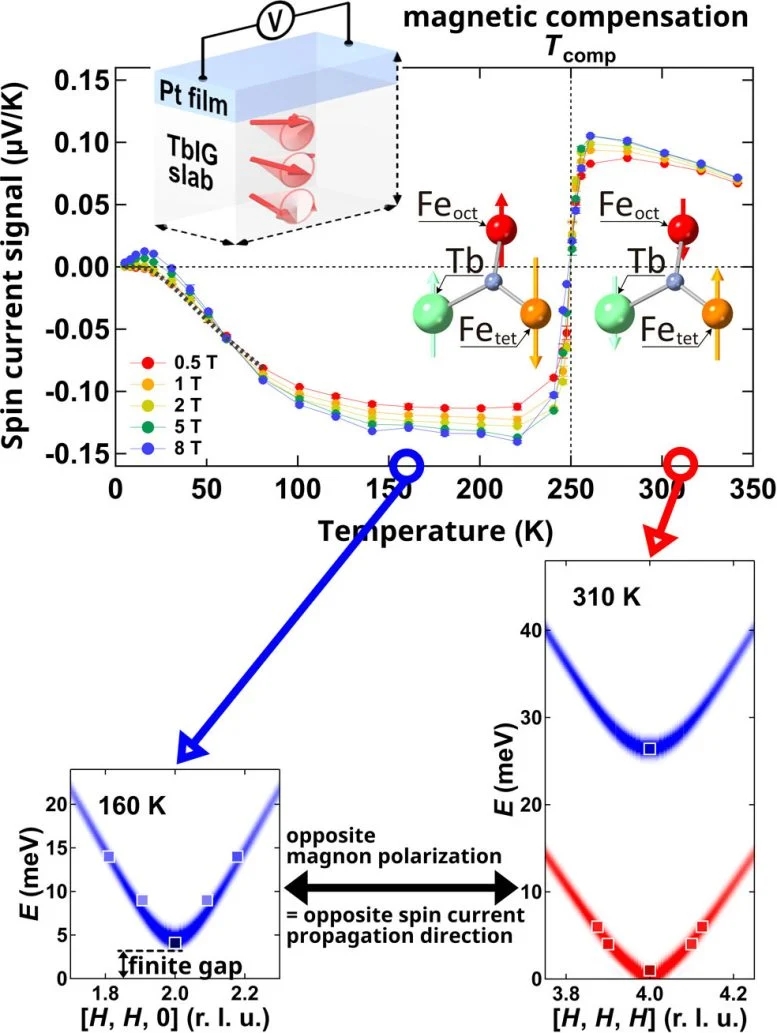博文
自旋秘密解锁:自旋电子学的新里程碑可能彻底改变电子学
 精选
精选
||
自旋秘密解锁:自旋电子学的新里程碑可能彻底改变电子学
诸平
https://www.tohoku.ac.jp/en/press/unlocking_spin_current_secrets.html
据日本东北大学(Tohoku University)2024年6月9日提供的消息,自旋秘密解锁:自旋电子学的新里程碑可能彻底改变电子学(Spin Secrets Unlocked: New Milestone in Spintronics Could Revolutionize Electronics)。
自旋电子学(Spintronics)的最新进展通过研究材料的磁性和温度效应,使自旋电流能够更好地预测和控制。自旋电子学作为传统电子学(conventional Electronics)的一种有前途的替代品,正吸引着人们的极大兴趣,它提供了诸如更低的功耗、更快的操作、非挥发性以及引入新功能的可能性等潜在优势。
自旋电子学利用了电子固有的自旋,而该领域的基础是控制自旋自由度的流动,即自旋电流(spin currents)。科学家们一直在寻找创造、移除和控制它们的方法,以用于未来的应用。相关研究结果于2024年3月27日已经在《应用物理快报》(Applied Physics Letters)杂志网站发表——Y. Kawamoto, T. Kikkawa, M. Kawamata, Y. Umemoto, A. G. Manning, K. C. Rule, K. Ikeuchi, K. Kamazawa, M. Fujita, E. Saitoh, K. Kakurai, Y. Nambu. Understanding spin currents from magnon dispersion and polarization: Spin-Seebeck effect and neutron scattering study on Tb3Fe5O12. Applied Physics Letters, 2024, 124, 132406. DOI: 10.1063/5.0197831 ePub. 27 March 2024. https://doi.org/10.1063/5.0197831
参与此项研究的还有来自日本东京大学(University of Tokyo, Tokyo, Japan)、澳大利亚核科学技术组织(Australian Nuclear Science and Technology Organisation, Locked Bag 2001, Kirrawee DC, NSW 2232, Australia)、日本东海的高能加速器研究机构(High Energy Accelerator Research Organization, Tokai, Japan)、日本东海的科学与社会综合研究机构(Comprehensive Research Organization for Science and Society, Tokai, Japan)、日本原子能机构先进科学研究中心(Advanced Science Research Center, Japan Atomic Energy Agency, Tokai, Japan)、日本埼玉的理研新兴物质科学中心(RIKEN Center for Emergent Matter Science, Saitama, Japan)的研究人员。
探测自旋电流并非易事。它需要使用宏观电压测量,它观察整个材料的电压变化。然而,一个常见的绊脚石是缺乏对这种自旋电流如何在材料内部实际移动或传播的理解。
“通过中子散射和电压测量,我们证明了材料的磁性可以预测自旋电流如何随温度变化,”该论文的合著者、日本东北大学材料研究所{Tohoku University’s Institute for Materials Research (IMR)}副教授南部雄亮(Yusuke Nambu)指出。
磁振子极化的观测(Observations on Magnon Polarization)
南部雄亮和他的同事发现,自旋电流信号在特定的磁温度下改变方向,在低温下减弱。此外,他们发现自旋方向,或磁振子极化,在这个临界磁温上下都翻转。磁振子极化的变化与自旋电流的反转有关,从而揭示了自旋电流的传播方向。
此外,所研究的材料表现出具有明显间隙能的磁性行为。这表明,低于与该间隙能相关的温度,自旋电流载流子不存在,导致在较低温度下观察到的自旋电流信号减少。值得注意的是,自旋电流的温度依赖性遵循指数衰减,反映了中子散射的结果。
南部雄亮强调,他们的发现强调了在自旋电子学研究中理解微观细节的重要性。“通过澄清磁性行为及其温度变化,我们可以全面了解绝缘磁体中的自旋电流,为更准确地预测自旋电流铺平道路,并有可能开发具有增强性能的先进材料。”
上述介绍,仅供参考。欲了解更多信息,敬请注意浏览原文或者相关报道。
Magnon spin currents in the ferrimagnetic garnet Tb3Fe5O12 with 4f electrons were examined through the spin-Seebeck effect and neutron scattering measurements. The compound shows a magnetic compensation, where the spin-Seebeck signal reverses above and below Tcomp = 249.5 ( 4 ) K. Unpolarized neutron scattering unveils two major magnon branches with finite energy gaps, which are well explained in the framework of spin-wave theory. Their temperature dependencies and the direction of the precession motion of magnetic moments, i.e., magnon polarization, defined using polarized neutrons, explain the reversal at Tcomp and decay of the spin-Seebeck signals at low temperatures. We illustrate an example that momentum- and energy-resolved microscopic information is a prerequisite to understand the magnon spin current.
https://blog.sciencenet.cn/blog-212210-1437607.html
上一篇:流行的无糖甜味剂与心脏病发作和中风有关
下一篇:科学家们解决了雷诺兹的世纪流体流动之谜

